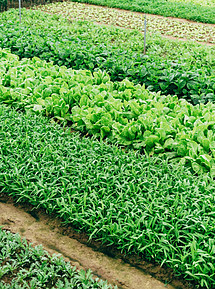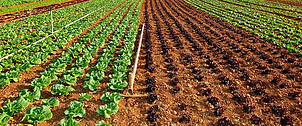Crop rotation is the process of cultivating vegetables and fruits in a separate soil patch every season. Rotating your crops adequately is ultimately a matter of thorough planning. Once you’ve resolved on what you want to grow, divide your garden into different pieces of land and allocate one type of crop to each. In this tutorial, you’ll learn how to grow vegetables and fruits.
You will transfer your favorite plants to a new portion of land every growing season, exposing them to nutrient-rich, fresh soil where they can thrive.
Isolating Your Garden
1. Map Out Your Crops into Groups
Once you’ve decided what to grow, designate your choices to one of 4 suits: Leaf crops, Fruit crops, Legumes, and Root crops. Since the plants in each suit exhaust identical levels of soil nutrients, separating them by type is much easier than attempting to choose where to place them discretely.
- Famous leafy greens such as spinach, cabbage, and lettuce are hefty feeders that should belong to crops of low nutrient in the garden
- Legumes with peas, beans, and all other vegetables that are cultivated in a pod, restore nitrogen to the soil
- Root crops like radishes, carrots, turnips, and onions can survive on some nutrients and require little maintenance
- Fruit crops comprise those like peppers, cucumbers, and they need a lot of nutrients to bring out their meaty, colorful fruit
2. Decide the Nutrient Requirements of Each Group
Find out about the crops you decided to grow and how demanding they will be on your garden’s soil. Hefty feeders such as cabbage, tomatoes, and corn, for instance, can evacuate large amounts of nutrients each season. Light feeders such as herbs and root veggies feed on comparatively low soil levels.
- Getting to know a lot about your plants’ special requirements will enable you to adjust your circling plan, so they can have the highest possibility of succeeding
- Legumes are in a group of their own. Literally, they boost the health of the soil by bringing vital nitrogen into the soil via a practice known as fixation of nitrogen
3. Appoint a Plot for Each Plant
You may want to situate your legumes together with some fruit crops like squash or tomatoes, or some leafy green root crops. The disposition will only be crucial after the first cultivating season when the soil comprising each type of soil has been exhausted.
- The old-fashioned 8-crop rotation project can be an excellent place, to begin with, if you are a novice to crop rotation. It attracts 8 simple crops: cabbage, potatoes, beans, peas, squash, root crops, tomatoes, sweet corn
- To retain maximum nutrients, alternate between light feeders and hefty feeders.
4. Leave a Minimum of One Plot Desolate
For effective crop rotation, you must find ample room to plant all that you intend to cultivate and have at least one patch of soil left out all the time. Leaving an empty plot fallow will give the soil a vacation and get it ready for the next cultivating season.
- If you don’t intend to grow a specific crop type, utilize the extra plot planting more of the veggies and fruits you desire
- You can alternatively leave at least a plot unused (suitably on opposite sides of the garden) to allow more time for the soil to recover.
Planting and Harvesting the Crops
1. Plant and Grow Your Crops
Break up the soil in your cultivating site moderately and plant seeds for the corresponding crops. For your palatable homegrown vegetables and fruits to start springing up, it will take a couple of weeks. The crop determines the precise time of the year to plant; thus, ensure you master each type of plant and figure out when to insert it in the soil.
- Stick to crop having identical planting and harvesting plans and boost the efficiency and arrangement of your rotation circles.
2. Harvest the Plants from Your First Cultivating Season
Once your garden items have become ripe, market them, and earn as much as possible. Do not leave any veggies unused. Your next move should be relocating the crops.
- Keep the crops intact until they are ripe for harvesting. With most crop types, you will need a couple of weeks to harvest and replant and make everything suffice as much as possible
3. Revive Your Soil Using Fertilizer
After carrying out the first season’s harvesting, inspect the soil at your cultivating site firmly. Use a little portion of nitrogen-rich natural fertilizer to return important nutrients and ensure that the subsequent cultivating season is profitable.
- Humus, manure, and compost tend to produce the most favorable fertilizers for crop gardens in a dry climate
- It isn’t necessary to fertilize in most cases. As a matter of fact, one of the main benefits of crop rotation is that it reduces the need to make use of fertilizers as frequently as for old-fashioned gardening techniques.
Proceeding with Your Crop Rotation
Cultivate your freshly-chosen plots and supply the empty soil with air effectively. Move every crop in a clockwise direction to its new landing place and plant it again. It will, of course, leverage a myriad of soil conditions that will boost healthy growth and prevent diseases and pests from springing up.
- Remember to move your vacant plot around. This way, each soil patch will have an overall cultivating season to regain strength
- The most usual installation in rotation gardening is a fundamental clockwise rotation. As long as no soil patch attracts similar Crop Two seasons in a linear direction, you may move your plants in a counterclockwise direction across opposite plots.
1. Modify Your Rotation Schedule if Your Plants are Disappointing
At a later time, you may find that a specific rotation performs better theoretically than it does within your garden. Note that crops that are nutrient-rich should be transferred to plots initially occupied by less nutritive crops, and vice versa.
- It takes a number of seasons to figure out what is most effective for a specific crop selection
- To restore struggling crops, keep at the basics of crop rotation
2. Map Out Your Crops Between Seasons
To bring in new crop selections to your garden, the appropriate time to do that is prior to the beginning of the next cultivating season. After a successful harvest, until a plot and use it to cultivate vegetables or fruits with nutrient requirements that match the current level of the soil.
* Hefty feeders such as Swiss chard, or pumpkin will perform best in a plot that kept legumes or light feeders the previous season. Allow for local periodic offerings every year to make the most of dynamic growing conditions.
I hope you enjoyed reading these articles and if you have any questions or something to share about these articles, please leave your comments below and I’ll happy to get back to you.
Thank you so much and happy gardening.


Alblue
Oh, this is such great information. My uncle just bought am empty lot and he wants to turn it into a variety garden. I want to ask a question, is the crop rotation technique that you mentioned above also applied to the country with two seasons (drought and rainy)? I’ll send your website to my uncle, he will love to read your articles here.
admin
Hi Alblue,
Thank you so much for your time visiting my website and reading my articles about, how to explore crop rotation in a garden. Thank you so much that you’re sharing my articles with your uncle. Yes, I believe a crop rotation technique can be applied to two seasons, and it’s good to select the right variety for your soil. For more questions do not hesitate to connect with me.
Best wishes to you and to your family.
Joyce
Jackie
My family has a long stretch of land and I felt it would be good to try to make good use of it by making it a farm but I understand the many hardships that one can face with it especially when it’s a big land too. Crip rotation offers a good possibility with farming which is why I had to make some research on it. Is there any benefits to the soil??
admin
Hi Jackie,
Thank you for dropping by and reading my articles about how to explore crop rotation in gardening. Soil is a very important aspect of a plant as they get nutrients from there. Before scheduling your plantation, the first thing first is the soil need to be ready-mixed with decomposing and manure on it.
Thank you so much and have a good day,
Joyce